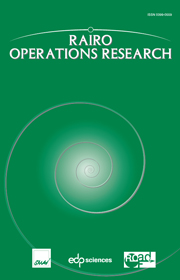Article contents
The Maximum Capacity Shortest Path Problem:Generationof Efficient Solution Sets
Published online by Cambridge University Press: 15 July 2002
Abstract
Individual items of flow in a telecommunications or a transportation network may need to beseparated by a minimum distance or time, called a “headway”. If link dependent, such restrictions in general have the effect that the minimum time path for a “convoy” of items to travel from a given origin to a given destinationwill depend on the size of the convoy. The Quickest Path problemseeks a path to minimise this convoy travel time.A closely related bicriterion problem is the Maximum Capacity Shortest Path problem. For this latter problem,an effective implementation is devised for an algorithm to determine desired sets of efficient solutions which in turn facilitates the searchfor a “best” compromise solution. Numerical experience with the algorithm is reported.
- Type
- Research Article
- Information
- Copyright
- © EDP Sciences, 2002
References
- 3
- Cited by


